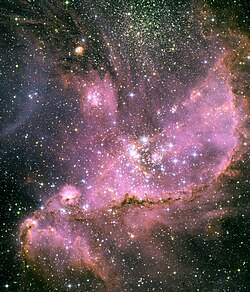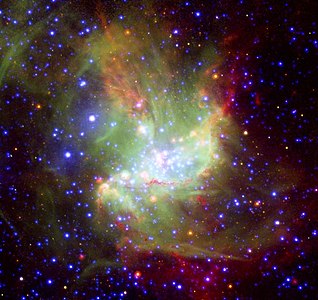NGC 346
| NGC 346 | |
|---|---|
 Hubble Space Telescope image of NGC 346 Credit: HST/NASA/ESA | |
| Observation data (J2000 epoch) | |
| Constellation | Tucana[1] |
| Right ascension | 00h 59m 05.090s[2] |
| Declination | −72° 10′ 33.24″[2] |
| Distance | 210,000 light-years |
| Physical characteristics | |
| Notable features | H II region |
| Other designations | ESO 51-10,[3] N66 |
NGC 346 is a young[4] open cluster of stars with associated nebula located in the Small Magellanic Cloud (SMC) that appears in the southern constellation of Tucana. It was discovered August 1, 1826 by Scottish astronomer James Dunlop. J. L. E. Dreyer described it as, "bright, large, very irregular figure, much brighter middle similar to double star, mottled but not resolved".[5] On the outskirts of the cluster is the multiple star system HD 5980,[6] one of the brightest stars in the SMC.
This cluster is located near the center of the brightest H II region in the SMC, designated N66.[7] This is positioned in the northeast section of the galactic bar.[8] Stellar surveys have identified 230 massive OB stars in the direction of this cluster.[4] 33 of the cluster members are O-type stars, with 11 of type O6.5 or earlier.[8] The inner 15 pc radius of the cluster appears centrally condensed, while the area outside that volume is more dispersed.[9] The youngest cluster members near the center have ages of less than two million years,[7] and observations suggests the cluster is still engaged in high mass star formation.[7] The cluster star formation rate is estimated at (4±1)×10−3 M☉ yr–1.[9]
| Walborn
number |
ELS
number |
MPG
number |
NMC
number |
SSN
number |
Effective
temperature (K) |
Absolute
magnitude |
Bolometric
magnitude |
Mass (M☉) | Spectral type |
|---|---|---|---|---|---|---|---|---|---|
| 207758 | 755 (HD 5980/AB5) | 45000
45000 34000 |
−8.1
(−7.1/−6.8/−6.7) |
-11.135
-10.885 -9.885 |
61/66/34 | LBV+WN4+OI | |||
| 1 | 435 | 26 | 7 | 43400 | -6.7 | -10.7 | 91 | O5.5If | |
| 1 | 789 | 5 | 38900 | -7 | -10.7 | 85 | O7If | ||
| 3 | 355 | 29 | 9 | 51300 | -5.7 | -10.3 | 76 | O3V | |
| 6 | 7 | 324 | 32 | 13 | 48600 | -5.2 | -9.6 | 54 | O4V |
| 4 | 342 | 30 | 11 | 44900 | -5.5 | -9.7 | 53 | O5.5V | |
| 368 | 28 | 15 | 44900 | -5 | -9.2 | 43 | O5.5V | ||
| 2 | 470 | 25 | 35700 | -5.4 | -8.9 | 34 | O8.5III |
Gallery[]

ESO image of NGC 346

ESO image of NGC 346
References[]
- ^ "Hubble Heritage Site". Results for NGC 346. Retrieved 2007-04-03.
- ^ a b Sturm, R.; et al. (October 2013). "The XMM-Newton survey of the Small Magellanic Cloud: The X-ray point-source catalogue". Astronomy & Astrophysics. 558: 31. arXiv:1307.7594. Bibcode:2013A&A...558A...3S. doi:10.1051/0004-6361/201219935. A3.
- ^ "NGC 346". SIMBAD. Centre de données astronomiques de Strasbourg. Retrieved 2007-04-17.
- ^ a b Dufton, P. L.; et al. (February 2020). "The NGC 346 massive star census. Nitrogen abundances for apparently single, narrow lined, hydrogen core burning B-type stars". Astronomy & Astrophysics. 634: 15. arXiv:1912.07539. Bibcode:2020A&A...634A...6D. doi:10.1051/0004-6361/201936921. A6.
- ^ Seligman, Courtney. "New General Catalogue objects: NGC 300 - 349". cseligman.com. Retrieved 2020-09-17.
- ^ Nazé, Y.; et al. (November 2002). "An X-Ray Investigation of the NGC 346 Field in the Small Magellanic Cloud I. The Luminous Blue Variable HD 5980 and the NGC 346 Cluster". The Astrophysical Journal. 580 (1): 225–234. arXiv:astro-ph/0208289. Bibcode:2002ApJ...580..225N. doi:10.1086/343079.
- ^ a b c Dufton, P. L.; et al. (June 2019). "A census of massive stars in NGC 346. Stellar parameters and rotational velocities". Astronomy & Astrophysics. 626: 28. arXiv:1905.03359. Bibcode:2019A&A...626A..50D. doi:10.1051/0004-6361/201935415. A50.
- ^ a b Rubio, M.; et al. (July 2018). "Massive young stellar objects in the N 66/NGC 346 region of the SMC". Astronomy & Astrophysics. 615: 9. arXiv:1803.10833. Bibcode:2018A&A...615A.121R. doi:10.1051/0004-6361/201730487. A121.
- ^ a b Hony, S.; et al. (April 2015). "Star formation rates from young-star counts and the structure of the ISM across the NGC 346/N66 complex in the SMC". Monthly Notices of the Royal Astronomical Society. 448 (2): 1847–1862. arXiv:1501.03634. Bibcode:2015MNRAS.448.1847H. doi:10.1093/mnras/stv107.
- ^ Massey, Philip; Waterhouse, Elizabeth; DeGioia-Eastwood, Kathleen (May 2000). "The Progenitor Masses of Wolf-Rayet Stars and Luminous Blue Variables Determined from Cluster Turnoffs. I. Results from 19 OB Associations in the Magellanic Clouds". The Astronomical Journal. 119 (5): 2214–2241. arXiv:astro-ph/0002233. Bibcode:2000AJ....119.2214M. doi:10.1086/301345. ISSN 0004-6256. S2CID 16891188.
External links[]
 Media related to NGC 346 at Wikimedia Commons
Media related to NGC 346 at Wikimedia Commons- [http://www.esa.int/esaSC/SEMLKL4N0MF_index_0.html ESA'
- Hubble Heritage site Hubble picture and information on NGC 346
- ESO Beautiful Image of a Cosmic Sculpture
- NASA Astronomy Picture of the Day: Young Stars of NGC 346 (28 September 2008)
- NASA Astronomy Picture of the Day: NGC 346 in the Small Magellanic Cloud (17 October 2010)
- Open clusters
- H II regions
- Star-forming regions
- Small Magellanic Cloud
- Tucana (constellation)
- NGC objects
- Astronomical objects discovered in 1826

